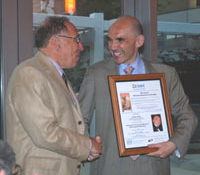Sergio Verdu Presents Claude E. Shannon Memorial Lecture
By Tiffany Fox, (858) 246-0353, tfox@ucsd.edu
|
San Diego CA, May 2, 2008 -- Award-winning Princeton University professor Sergio Verdú, recipient of the 2007 Claude E. Shannon Award, presented UC San Diego's Center for Magnetic Recording Research's (CMRR) sixth annual Shannon Memorial Lecture at the Calit2 Auditorium Wednesday in front of a full house of students, faculty and members of the community.
Each year on or around Shannon’s birthday, CMRR, with support from Calit2 and its Information Theory and Applications Center (ITA), invites a guest speaker to lecture in honor of the late information theorist. Coincidentally – and befitting of Verdú’s lecture topic – Shannon shares his April 30 birth date with Carl Friedrich Gauss, the German mathematician and physicist who is considered to be the progenitor of estimation theory. Although the two men were born nearly 140 years apart, there are important correlations between their theories. Verdú sought to illustrate these correlations in his lecture titled “Information Theory and Minimum Mean-Square Estimation (MMSE).”
|
Verdú used several real-life examples to illustrate his research, including algorithms for analyzing MMSE in the stock market, DSL lines, the wireless CDMA technology developed by Qualcomm, and even an electronic version of Miguel de Cervantes’ Don Quixote de la Mancha . Verdú, a Spaniard himself, said he had derived one of the mathematical formulas in his lecture just the week before.
“Information theory is something that drives technology,” he said. “It is able to predict what new technologies are going to deliver, so it never gets obsolete. It can also have unexpected implications for estimation theory. It turns out that the world of Shannon, or digital communication, has something to do with the world of signal processing, whose origins go all the way back to Gauss.”
And what would Shannon think of Verdú’s research?
"The tendency is to try to tackle too many problems, but Shannon was always emphasizing that in research you should always look at simple models,” Verdú said. “You should make it complicated enough that it’s challenging and interesting, but not more. I’m following that philosophy.”
In addition to receiving the 2007 Shannon award, Verdú won the 2008 Institute for Electrical and Electronic Engineers' (IEEE) Richard W. Hamming Medal. He is the recipient of several paper awards from the IEEE, including the 1992 Donald Fink Paper Award, the 1998 Information Theory Outstanding Paper Award, the Information Theory Golden Jubilee Paper Award, the 2002 Leonard Abraham Prize Award and the 2006 Joint Communications/ Information Theory Paper Award.
Verdú's doctoral reasearch pioneered the field of multiuser detection, which, in wireless communications, helps the receiver detect original signals from interfering signals. His book Multiuser Detection, published in 1998 by Cambridge University Press, was awarded the Frederick E. Terman Award from the American Society for Engineering Education.
Media Contacts
Tiffany Fox, (858) 246-0353, tfox@ucsd.edu,
Related Links



.jpg)